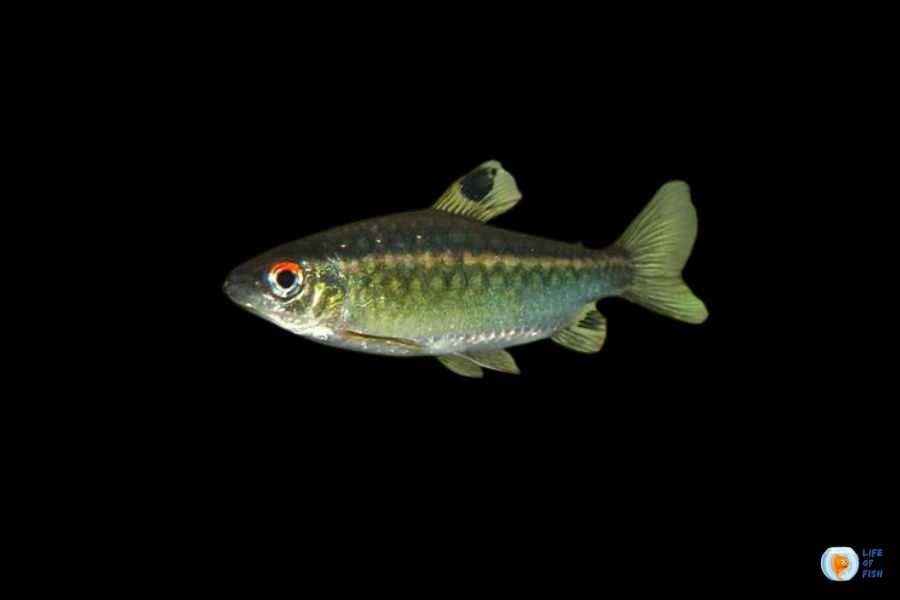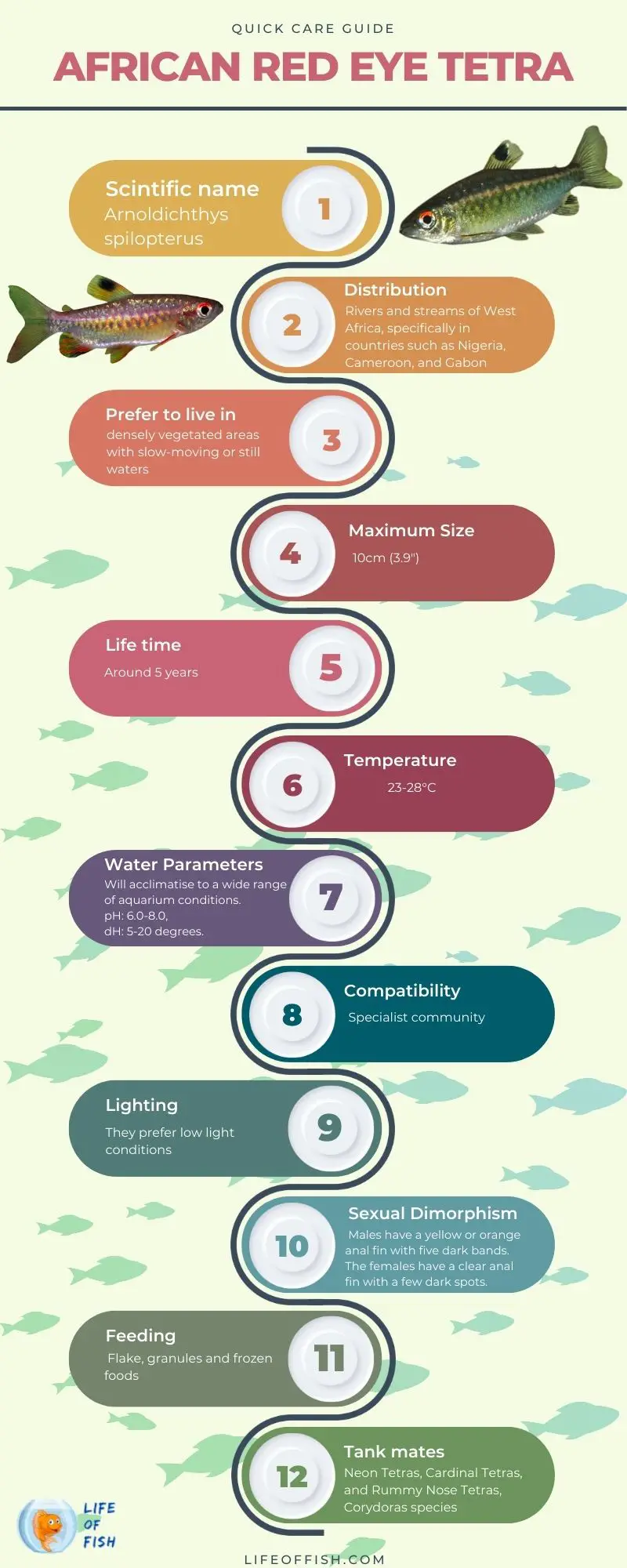The African Red Eye Tetra is a captivating freshwater fish known for its stunning red eyes and vibrant colors. If you’re looking to add a touch of exotic beauty to your aquarium, this species is an excellent choice.
In this article, we will explore the physical characteristics, natural habitat, tank setup, feeding habits, compatible tankmates, breeding techniques, common diseases, and tips for maintaining the health of African Red Eye Tetras.

The African Red Eye Tetra (Arnoldichthys spilopterus) is a small-sized fish native to the rivers and streams of West Africa. These tetras belong to the Characidae family and are highly sought after by aquarists for their striking appearance and peaceful temperament. With proper care and attention, they can thrive in a well-maintained aquarium.

Physical Appearance of the African Red Eye Tetra
Jump To
- 1 Physical Appearance of the African Red Eye Tetra
- 2 Natural Habitat and Distribution
- 3 Tank Setup and Water Conditions
- 4 Diet and Feeding Habits
- 5 How big do red eye tetras get?
- 6 Compatible Tankmates for the African Red Eye Tetra
- 7 Breeding the African Red Eye Tetra
- 8 Common Diseases and Health Issues
- 9 Tips for Maintaining a Healthy Aquarium
- 10 Conclusion
- 11 FAQ
I mainly identify them by their fiery red eyes. Those eyes provide a beautiful contrast against its silver-colored body. These tetras have a streamlined and elongated body shape, which allows them to swiftly navigate through the water. The body is adorned with iridescent scales, reflecting hues of blue, green, and red when light hits them at different angles.
Natural Habitat and Distribution
African Red Eye Tetras are native to the rivers and streams of West Africa, specifically in countries such as Nigeria, Cameroon, and Gabon. In the wild, they inhabit densely vegetated areas with slow-moving or still waters. These habitats often provide shelter and ample food sources for the tetras.
Tank Setup and Water Conditions
When setting up a tank for African Red Eye Tetras, it is important to replicate their natural environment as closely as possible. A tank with a capacity of at least 20 gallons is recommended to provide enough swimming space for a small school of tetras. It is crucial to maintain stable water conditions, including a temperature range of 75-80°F (24-27°C) and a pH level around 6.5-7.5.
To mimic their natural habitat, incorporate plants such as Java moss, Amazon swords, and floating plants. These plants not only add aesthetic value but also provide hiding spots and areas for the tetras to explore. Driftwood and rocks can also be included to create additional hiding places and territorial boundaries.
Ensure proper lighting for the tank, with a balance between light and shade. A gentle water flow can be achieved with the help of a suitable filtration system, as African Red Eye Tetras prefer calm or slow-moving waters.
Diet and Feeding Habits
African Red Eye Tetras are omnivorous and will readily accept a variety of foods. In their natural habitat, they primarily feed on small insects, crustaceans, and plant matter. In a home aquarium, their diet can be supplemented with high-quality flake or pellet foods specifically designed for tropical fish.
To provide a well-rounded diet, incorporate occasional feedings of live or frozen foods such as brine shrimp, bloodworms, and daphnia. This helps mimic their natural feeding behavior and provides necessary nutrients for their overall health and coloration. It is important to feed them small portions multiple times a day to prevent overeating and maintain water quality.
How big do red eye tetras get?
Red Eye Tetras (Arnoldichthys spilopterus) typically reach a maximum size of around 2.5 to 3 inches (6 to 8 centimeters) in length. They are considered a small-sized fish species, making them well-suited for community aquariums and smaller tanks. The vibrant colors and striking red eyes of these tetras add a visually appealing touch to any aquarium setup.
Compatible Tankmates for the African Red Eye Tetra
African Red Eye Tetras are peaceful community fish and can coexist with a wide range of tankmates. It is best to keep them in a group of at least six individuals to promote their natural schooling behavior and reduce stress. Some suitable tankmates include other peaceful tetra species, such as Neon Tetras, Cardinal Tetras, and Rummy Nose Tetras.
Small-sized catfish, such as Corydoras species, can also make good tankmates as they inhabit different areas of the tank and have similar peaceful temperaments. Avoid keeping African Red Eye Tetras with aggressive or large species that may intimidate or prey upon them.
Are red eye tetras aggressive?
Red Eye Tetras (Arnoldichthys spilopterus) are generally peaceful and not known for being aggressive. They have a calm temperament and are often kept in community aquariums with other peaceful fish species.
However, it is important to note that individual fish behavior can vary, and there may be instances of territoriality or aggression, especially during breeding or if the tank is overcrowded.
Providing ample space, suitable hiding spots, and a well-balanced community of compatible tankmates can help minimize any potential aggression. Monitoring the fish’s behavior and ensuring a harmonious tank environment will contribute to a peaceful coexistence among the inhabitants.
Breeding the African Red Eye Tetra
Breeding African Red Eye Tetras can be an exciting endeavor for experienced aquarists. To encourage breeding, it is important to provide optimal conditions, including slightly acidic water with a pH around 6.5-6.8 and slightly higher temperatures around 80-82°F (27-28°C).
The use of a separate breeding tank with fine-leaved plants, such as Java moss or spawning mops, can help simulate their natural spawning environment. Introduce a well-conditioned pair of tetras into the breeding tank and provide a protein-rich diet to enhance their reproductive capabilities.
Do red eye tetras lay eggs?
Yes, During the spawning process, the female will scatter adhesive eggs among the plants, which the male will then fertilize. After spawning, remove the adults from the breeding tank to prevent them from consuming the eggs.
The eggs typically hatch within 24-48 hours, and the fry can be fed infusoria or commercially available liquid fry food until they are large enough to accept finely crushed flake foods.
Common Diseases and Health Issues
Like any fish species, African Red Eye Tetras are susceptible to certain diseases and health issues.
Common diseases that may affect African Red Eye Tetras include bacterial infections, fungal infections, and parasitic infestations. It is important to monitor their behavior and appearance regularly to detect any signs of illness.
Symptoms of disease in African Red Eye Tetras may include loss of appetite, abnormal swimming patterns, color fading, frayed fins, or the presence of white spots or lesions on their bodies. If any of these symptoms are observed, it is crucial to take prompt action.
To prevent diseases, maintain excellent water quality through regular water changes and proper filtration. Avoid introducing sick or stressed fish into the aquarium and quarantine new additions before adding them to the main tank.
If a disease is detected, appropriate treatment options should be implemented promptly. This may include using medications specifically designed for treating bacterial, fungal, or parasitic infections. Follow the instructions provided by the manufacturer and consult with a knowledgeable aquarist or veterinarian if necessary.
Tips for Maintaining a Healthy Aquarium
To ensure the well-being of African Red Eye Tetras and the overall health of your aquarium, consider the following tips:
- Perform regular water tests to monitor parameters such as ammonia, nitrite, nitrate, and pH levels. Take corrective actions if any levels are out of range.
- Maintain a consistent temperature and provide appropriate lighting for the aquarium inhabitants.
- Clean the tank and equipment regularly to remove debris and prevent the buildup of harmful substances.
- Feed a varied and balanced diet, and avoid overfeeding to maintain water quality.
- Observe the behavior and appearance of the fish daily to detect any signs of illness or stress.
By following these guidelines, you can create a thriving and vibrant aquarium environment for your African Red Eye Tetras.
Conclusion
The African Red Eye Tetra is a visually stunning and peaceful freshwater fish species that can bring a touch of vibrancy to any aquarium. With their fiery red eyes and iridescent colors, these tetras are a captivating addition to a community tank.
By understanding their natural habitat, providing suitable tank conditions, offering a balanced diet, and maintaining optimal water quality, you can ensure the well-being of your African Red Eye Tetras. Additionally, the joy of observing their breeding behaviors and successfully raising the fry can be a rewarding experience for dedicated aquarists.
So, if you’re looking for an enchanting fish species that combines beauty, tranquility, and ease of care, consider adding the African Red Eye Tetra to your aquatic collection.
FAQ
- Can African Red Eye Tetras live with other tetra species?
- Yes, African Red Eye Tetras can coexist peacefully with other tetra species, such as Neon Tetras and Cardinal Tetras.
- How long do African Red Eye Tetras typically live?
- Under proper care, African Red Eye Tetras can live for around 3 to 5 years.
- What should I feed my African Red Eye Tetras?
- African Red Eye Tetras are omnivorous and can be fed high-quality flake or pellet foods supplemented with live or frozen foods like brine shrimp and bloodworms.
- How can I encourage breeding in my African Red Eye Tetras?
- To encourage breeding, provide optimal water conditions, including slightly acidic water and slightly higher temperatures. Use a separate breeding tank with fine-leaved plants and a well-conditioned pair of tetras.
- Are African Red Eye Tetras suitable for beginners?
- Yes, African Red Eye Tetras are generally considered suitable for beginners due to their peaceful nature and relatively easy care requirements.
